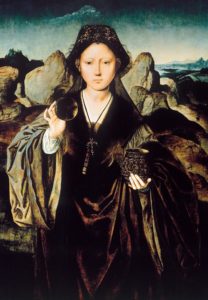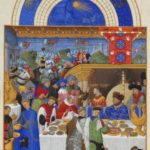Mary of Magdalene
Master of Mansi Magdalene (active 1510-1525), Mary of Magdalene, circa 1525, collection Gemäldegalerie, Berlin
In the art historical tradition, Mary of Magdalen is often pictured with an ointment jar. Besides being a visual representation of a recurring attribute, this jar is first and foremost an olfactory symbol, referring to the anointment of Jesus in Bethany.
In this story from the New Testament Jesus is invited by Lazarus’ to celebrate his resurrection (since Lazarus had been dead for a while, the ancient text mentions that he smelled quite foul). When Jesus arrived, Mary ‘took a pound of pure and very expensive spikenard oil. She poured it over his feet, and whipped them dry with her hair. The whole house was filled with fragrant perfume’.
Although the meaning has gone lost, this sentence is incredibly significant.
First of all a pound of spikenard would have cost a year income. This means Mary must have been quite wealthy and generous, suggesting she was very close to Jesus. Secondly the use of spikenard was restricted to kings, pharaoh’s, priests and God. By applying this specific oil, she was giving off a clear message: ‘someone of divine status is among us’. This message was immediately understood by everyone since ‘the whole house was filled with fragrant perfume’.
Finally, evangelist John mentions how Mary anoints Jesus’ feet. Since this is customary for the deceased, and not the living, Mary was demonstrably aware of Jesus’ untimely death which was to happen in a week from then.
This specific composition by the Master of Mansi – a Dutch Renaissance painter – is extraordinary and quite rare. Mary is positioned at half-length, full faced, looking the viewer straight in the eyes and opening her jar, actively involving you in the action. It is almost as if she wants to enable you to connect to the story by putting yourself in Jesus’ position, and imagining the smell escaping her jar like a fragrant promise.
Note to reader: Mary of Bethany and Mary of Magdalen are often confused in art history, but they are actually two different biblical figures, that both anointed Jesus at some point.
Caro Verbeek
Royal Academy of the Arts, The Hague
Vrije Universiteit Amsterdam
Mediamatic, Amsterdam


